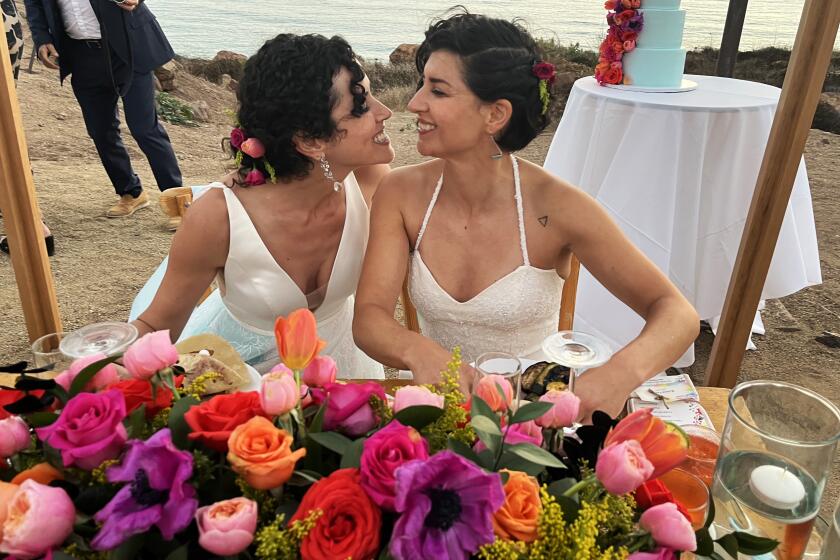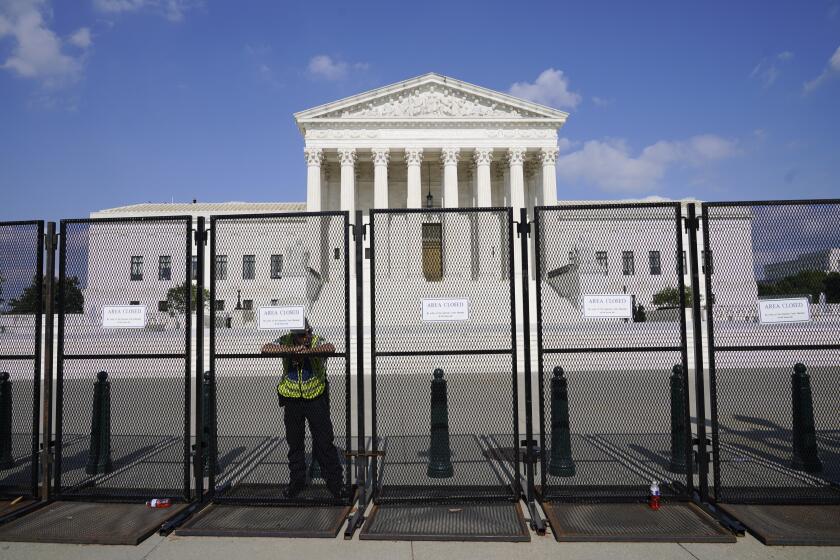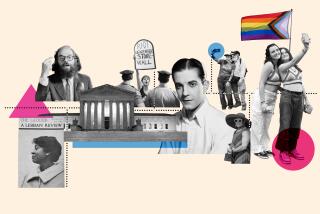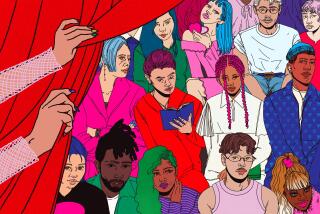Opinion: Interracial marriage went from criminal to commonplace. Could it go back?
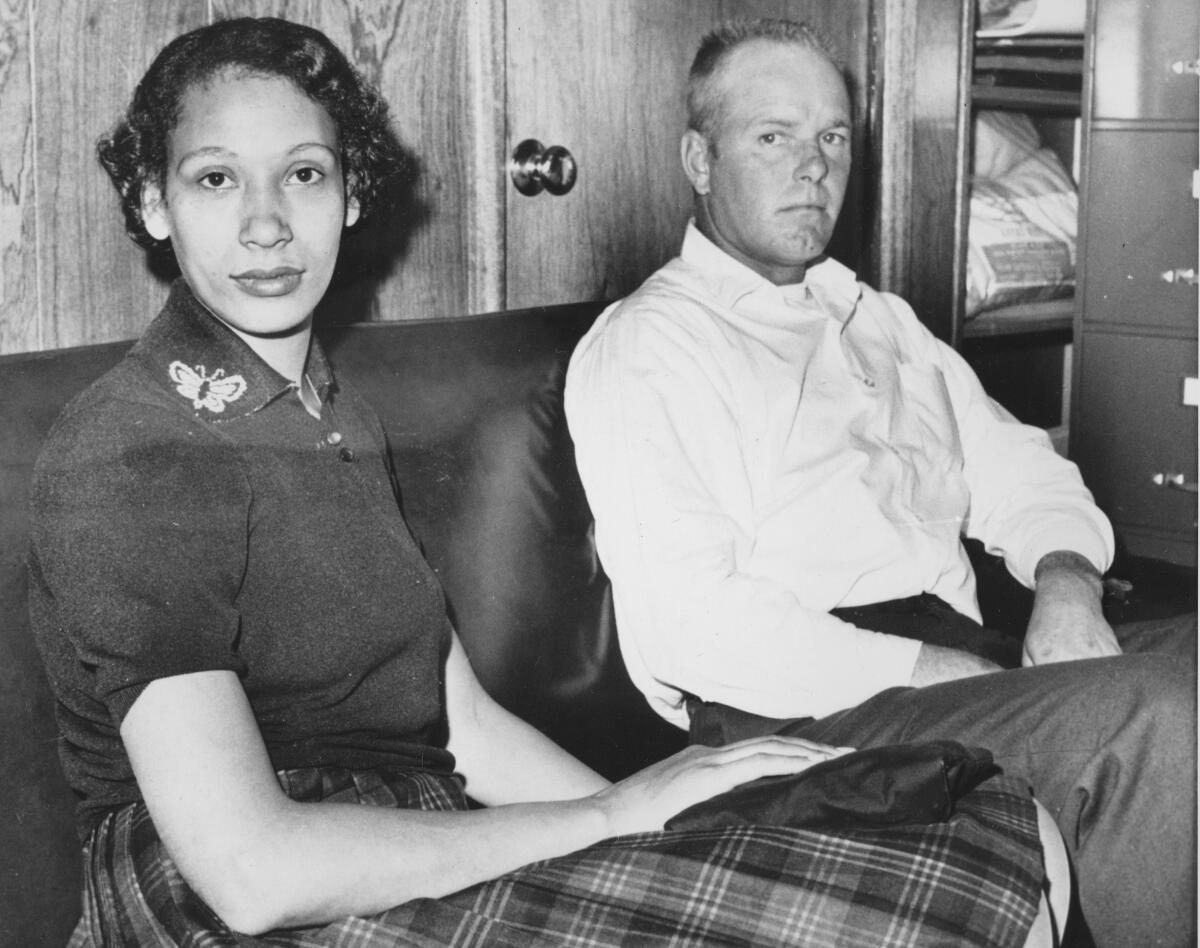
- Share via
American love stories have a default race: white. If the love story is “interracial,” one person is white, and the other person is not. In a standard American rom-com, the only nonwhite characters are the white lead’s helpful best friends or underwritten colleagues.
Quincy, a Black man, and I, a South Asian woman, are none of these things.
“All I could think on the way here is when am I going to kiss you,” Quincy told me one day in 2009, three weeks after we had met. It was the “when” that got me; I was that impatient too.
A new anti-gay-marriage push, energized by the overturning of abortion rights, is trying to make Americans believe the institution of marriage is diminished by same-sex unions.
More than 50 years earlier, on July 11, 1958, Richard and Mildred Loving woke up around 2 a.m. to find their local sheriff shining a flashlight over them.
“What are you doing in bed with this woman?” he demanded of Richard.
Richard was white, and Mildred was black.
The Lovings were charged with violating Virginia’s Racial Integrity Act of 1924, which criminalized marriage between people classified as “white” and “colored.” The Lovings took their case all the way to the U.S. Supreme Court, which unanimously struck down Virginia’s law and ended race-based legal marriage restrictions nationwide on June 12, 1967.
The date is now recognized by cities, states and organizations across the country as Loving Day. It should be a national holiday.
As a queer civil rights lawyer, I never imagined these basic rights would be granted and then threatened in my lifetime.
I’m not sure how the authorities would have regarded Q and me back then — whether we would have been deemed an interracial couple or not. Would they have even cared about our union given that neither of us is white?
What I do know is that paranoia about interracial relationships is not unique to white Americans.
Early 20th century Indian immigrants to the United States, for example, invoked anti-miscegenation rhetoric as a way of establishing their claims to citizenship. Bhagat Singh Thind, a writer and World War I veteran, used the language of caste apartheid to make his own case to the Supreme Court in 1923: “The high-caste Hindu regards the aboriginal Indian Mongoloid in the same manner as the American regards the Negro, speaking from a matrimonial standpoint.” His argument was, in short, that as a person of high caste, he was practically white and therefore eligible for citizenship under federal immigration law, which limited naturalization to people of European and African descent.
Thind’s gambit — to weaponize one kind of discrimination against another — failed. The court ruled against him, and some 50 Indian Americans had their citizenship revoked over the next three years as a result.
Five years after Loving vs. Virginia, my parents, joined by the kind of inter-caste “love” marriage that Thind argued against, would come to the United States. Their passage was facilitated by the Immigration and Nationality Act of 1965, with which the country opened its doors wider than ever to immigrants of Asian descent, though it prioritized skilled professionals who could contribute to the Space Race and other national priorities: scientists, engineers, doctors.
The U.S. government’s desire to beat the Russians may have played a role in the legislation, while schooling, class and caste privilege made medical and engineering degrees attainable for many Asian immigrants of the period. But it was the civil rights movement led by Black Americans that truly gave these newcomers a shot at a more humane, equitable life here.
And yet if it weren’t for Loving Day, I’m not sure I would have been aware of the Lovings as civil rights pioneers.
It was Quincy who pointed me to their story. In 2017, he — by then my husband — found a call for interracial couples to re-create an iconic 1965 image of Richard and Mildred Loving, shot by Grey Villet for Life magazine seven years after their arrest. I suggested we participate.
I always read the photo as showing Mildred in the course of doing something else when Richard scooped her into his arm. The husband’s face is tilted toward the camera as he leans in to kiss his wife. Mildred looks busy: Maybe it’s her posture, not leaning toward Richard but standing straight; maybe it’s her hair, not done up for the camera but in utilitarian bobby pins. It seems to capture a moment of embrace, of love, in the midst of a typical day.
Perhaps that’s what made me feel as if we could inhabit this photo. Quincy is always trying to scoop me up while I’m motoring about doing one of 10 million things in a day.
I think that’s the power of the photo. America doesn’t tend to read race as a love story. Race in America is seen as a story of pain and tragedy. But people are more than pain, more than tragic. Our lives together are ordinary as much as extraordinary.
That’s exactly what Richard and Mildred were fighting for: the right to an ordinary, kissing-amid-the-10-million-things-of-the-day kind of life.
The Lovings’ case would become a precedent for the Supreme Court’s ruling in Obergefell vs. Hodges, which legalized same-sex marriage in 2015. The court ruled that “the right to marry is a fundamental right inherent in the liberty of the person, and … couples of the same sex may not be deprived of that right and that liberty.”
The Pew Research Center found a more than fivefold increase in interracial marriage in the half-century since Loving vs. Virginia, with about 1 in 6 newlyweds married to someone of a different race.
For me, Loving Day is a testament to the everyday-ness of some civil disobedience. It’s also a challenge to the anti-Blackness that addles South Asian communities. From Thind onward, complicity in racism against Black people has been one way South Asians have tried to claim citizenship in America, so anti-Blackness is forever bound up with both assimilation and caste-based oppression.
“When am I going to kiss you?” Quincy said. We waited out of politeness, for privacy and to freely express our passion for each other. But that freedom is fragile.
In their dissent from the 2022 decision overturning Roe vs. Wade, Justices Stephen G. Breyer, Elena Kagan and Sonia Sotomayor warned that “no one should be confident that this majority is done with its work,” calling Roe and Obergefell “part of the same constitutional fabric, protecting autonomous decision making over the most personal of life decisions.”
Like the Lovings, we can’t be sure history won’t pluck us out of our 10 million things, threatening us with a flashlight from the edge of our bed. Loving Day is not merely to celebrate the past. It’s to ensure that a future of freedom for love in all its forms is not an “if” but a “when.”
Nina Sharma is the author of “The Way You Make Me Feel: Love in Black and Brown.”
More to Read
A cure for the common opinion
Get thought-provoking perspectives with our weekly newsletter.
You may occasionally receive promotional content from the Los Angeles Times.
